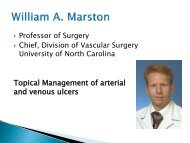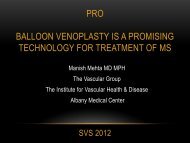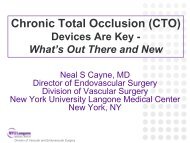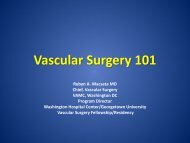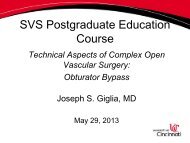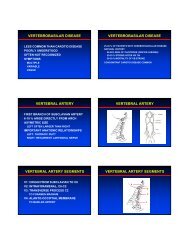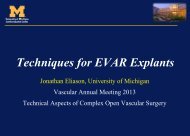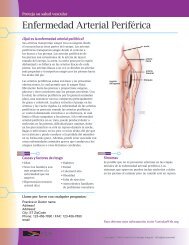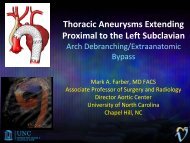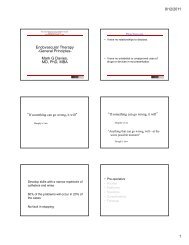Overview of Closure Devices â What's Out There, are ... - VascularWeb
Overview of Closure Devices â What's Out There, are ... - VascularWeb
Overview of Closure Devices â What's Out There, are ... - VascularWeb
You also want an ePaper? Increase the reach of your titles
YUMPU automatically turns print PDFs into web optimized ePapers that Google loves.
<strong>Overview</strong> <strong>of</strong> <strong>Closure</strong> <strong>Devices</strong> – What’s <strong>Out</strong><strong>There</strong>, <strong>are</strong> They Warranted and if so, When?Ali Azizzadeh, MD, FACSAssociate Pr<strong>of</strong>essorDirector <strong>of</strong> Endovascular SurgeryDepartment <strong>of</strong> Cardiothoracic and Vascular SurgeryThe University <strong>of</strong> Texas Medical School at HoustonMemorial Hermann Heart & Vascular InstituteSociety for Vascular SurgeryVascular Annual MeetingSan Francisco, CaliforniaMay 29, 2013
Disclosures• Consultant• WL Gore• Medtronic
• Sven Ivar Seldinger,Percutaneous Access,1953• Access sites managedwith ManualCompression (MC) fornext 30-40 yrs.Acta Radiologica (Stockholm) 39: 368-76. May 1953
Vascular <strong>Closure</strong> <strong>Devices</strong> (VCD’s)• Introduced in ‘80s• To limit the time, labor, bed rest, and patientdiscomfort• Incidence:• CathPCI Registry• 2005-2009• 1089 sites• 1,819,611 percutaneous coronary intervention(PCI) procedures• >60% VCD useTavris DR et al. J Invas Cardiol. 2012;24:328-334.
Vascular Surgery Consult?
Manual Compression• Easy, “ golden standard”• Need to interruptanticoagulation (wait forACT to decrease)• Patient and doctordiscomfort– 6 hours bedrest : backpain and urinaryretention– 15–30 min for a 6 FrsheathVascular <strong>Closure</strong> <strong>Devices</strong>• Improve patientcomfort• Free medical staffresources• Shortens the timeneeded forhemostasis,ambulation anddischarge• Risks <strong>of</strong> groin infectionand leg ischemia
Manual Compression• Remains the “gold standard” in achieving hemostasis<strong>of</strong> an arteriotomy site• The sheath can be removed:• immediately after a diagnostic procedure• delayed (<strong>of</strong>ten 2–4 hours) after an intervention: ACT
Vascular <strong>Closure</strong> <strong>Devices</strong>PASSIVE• Long Angle Entry• Arstasis• Hemostasis Pads• Chito Seal• CloSur PAD• Syvek Patch• Neptune Pad• D-Stat Dry• Compression <strong>Devices</strong>• Femo Stop• Clamp EaseACTIVE• Under Tension Umbrella• Plug• Collagen• AngioSeal• VasoSeal• Vascade• Polyglycolic Acid• Mynx• Exoseal• Intestine Submucosa• FISH• Clip• Starclip• Suture• Perclose ProGlide• Perclose Prostar
Vascular <strong>Closure</strong> <strong>Devices</strong>PASSIVE• Long Angle Entry• Arstasis• Hemostasis Pads• Chito Seal• CloSur PAD• Syvek Patch• Enhance• NeptunehemostasisPadwithprothrombotic• D-StatmaterialDryormechanical compression• Do not achieve prompt hemostasisor•shortenCompressionthe time to<strong>Devices</strong>ambulation.• FemoStop• Clamp EaseACTIVE• Under Tension Umbrella• Plug• Collagen• AngioSeal• VasoSeal• Vascade• Polyglycolic Acid• Mynx• Exoseal• Intestine Submucosa• FISH• Clip• Starclip• Suture• Perclose ProGlide• Perclose Prostar
Passive Vascular <strong>Closure</strong> <strong>Devices</strong>Self Sealing Arteriotomy: Axera (Arstasis)0.035’’ wire0.018” guidewire0.035’’ wire
Passive Vascular <strong>Closure</strong> <strong>Devices</strong>Self Sealing Arteriotomy: Axera (Arstasis)0.035’’ wire0.018” guidewire0.035’’ wireLong shallow-angle arteriotomy creates significant tissue-tissue overlap for hemostasis.
Passive Vascular <strong>Closure</strong> <strong>Devices</strong>Hemostasis PadsPASSIVE• Long Angle Entry• Arstasis• Hemostasis Pads• Chito Seal• CloSur PAD• Syvek Patch• Neptune Pad• D-Stat Dry• Compression <strong>Devices</strong>• FemoStop• Clamp EaseACTIVE• Under Tension Umbrella• Plug• Collagen• AngioSeal• VasoSeal• Vascade• Polyglycolic Acid• Mynx• Exoseal• Intestine Submucosa• FISH• Clip• Starclip• Suture• Perclose ProGlide• Perclose Prostar
Passive Vascular <strong>Closure</strong> <strong>Devices</strong>Hemostasis PadsPASSIVE• Long Angle Entry• Arstasis• Hemostasis Pads• Chito Seal• CloSur PAD• Syvek Patch• Neptune Pad• D-Stat Dry• Compression <strong>Devices</strong>• FemoStop• Clamp EaseACTIVE• Under Tension Umbrella• Plug• Collagen• AngioSeal• VasoSeal• Vascade• Polyglycolic Acid• Mynx• Exoseal• Intestine Submucosa• FISH• Clip• Starclip• Suture• Perclose ProGlide• Perclose Prostar
Passive Vascular <strong>Closure</strong> <strong>Devices</strong>- Hemostasis Pads• Chito-Seal: Abbott Vascular, Redwood City,California• Clo-Sur PAD: Scion Cardiovascular, Miami, Florida• SyvekPatch: Marine Polymer Technologies, Inc.,Dankers, Massachusetts• Neptune Pad: Biotronik, Berlin, Germany• D-Stat Dry: Vascular Solutions, Minneapolis,Minnesota
Pads <strong>are</strong> coated with procoagulant material to enhance coagulation and hemostasis.
Passive Vascular <strong>Closure</strong> <strong>Devices</strong>:Hemostasis Pads• Small randomized trials with patients undergoing:• Diagnostic or interventional coronary procedures:• Nguyen: RCT <strong>of</strong> topical hemostasis pad use for achieving vascularhemostasis after PCI. Catheter Cardiovasc Interv 2007• Mlekusch: Arterial puncture site management after PCI using ahemostatic wound dressing (Clo-Sur P.A.D.) versus conventional MC:A randomized controlled trial. J Endovasc Ther 2006• Balzer: Postinterventional percutaneous closure <strong>of</strong> femoral arteryaccess sites using the Clo-Sur PAD device: Initial findings. Eur Radiol2007• Peripheral percutaneous interventions• Mlekusch: Access site management after peripheral percutaneoustransluminal procedures: Neptune pad comp<strong>are</strong>d with conventionalmanual compression. Radiology 2008
Passive vascular closure deviceshemostasis pads• Technical failure:• 5–19% <strong>of</strong> Clo-Sur PAD cases• 8% <strong>of</strong> D-Stat Dry cases• Comp<strong>are</strong>d to MC:• Chito-Seal, Clo-Sur PAD or SyvekPatch: samecomplication rates• D-Stat Dry: reduced vascular complication rates• Neptune Pad: increased the risk <strong>of</strong> minor bleeding• Neptune Pad and Clo-Sur PAD: improved patient andphysician comfort• Hemostasis pads did not shorten the time to ambulationThe clinical utility <strong>of</strong> hemostasis pads is questionable sincetheir influence on hemostasis is small and they do notreduce the time to ambulation
Passive vascular closure deviceshemostasis pads• Technical failure:• 5–19% <strong>of</strong> Clo-Sur PAD cases• 8% <strong>of</strong> D-Stat Dry cases• Comp<strong>are</strong>d to MC:• Chito-Seal, Clo-Sur PAD or SyvekPatch: samecomplication rates• D-Stat Dry: reduced vascular complication rates• Neptune Pad: increased the risk <strong>of</strong> minor bleeding• Neptune Pad and Clo-Sur PAD: improved patient andphysician comfort• Hemostasis pads did not shorten the time to ambulationThe clinical utility <strong>of</strong> hemostasis pads is questionable sincetheir influence on hemostasis is small and they do notreduce the time to ambulation
Passive Vascular <strong>Closure</strong> <strong>Devices</strong>Compression <strong>Devices</strong>PASSIVEACTIVE• Long Angle Entry• Arstasis• Hemostasis Pads• Chito Seal• CloSur PAD• Syvek Patch• Neptune Pad• D-Stat Dry• Compression <strong>Devices</strong>• FemoStop• Clamp Ease• Under Tension Umbrella• Plug• Collagen• AngioSeal• VasoSeal• Vascade• Polyglycolic Acid• Mynx• Exoseal• Intestine Submucosa• FISH• Clip• Starclip• Suture• Perclose ProGlide• Perclose Prostar
Passive Vascular <strong>Closure</strong> <strong>Devices</strong>Compression <strong>Devices</strong>PASSIVEACTIVE• Long Angle Entry• Arstasis• Hemostasis Pads• Chito Seal• CloSur PAD• Syvek Patch• Neptune Pad• D-Stat Dry• Compression <strong>Devices</strong>• FemoStop• Clamp Ease• Under Tension Umbrella• Plug• Collagen• AngioSeal• VasoSeal• Vascade• Polyglycolic Acid• Mynx• Exoseal• Intestine Submucosa• FISH• Clip• Starclip• Suture• Perclose ProGlide• Perclose Prostar
Passive Vascular <strong>Closure</strong> <strong>Devices</strong>:Compression <strong>Devices</strong>• FemoStop plus Compression System: RadiMedical Systems, Inc., Reading, Massachusetts• The Clamp Ease device: Pressure Products Inc., RanchoPalos Verdes, California• High technical success rates approaching 100%• But do not shorten the time to hemostasis, ambulation or dischargecomp<strong>are</strong>d with MC; they simply replace human compression withmechanical compression
The FemoStop plus Compression SystemRadi Medical Systems, Inc., Reading, Massachusetts1. Inflated to ~70 mmHg while the sheath is removed,2. Then to suprasystolic pressure for ~2 minutes3. Deflated to the mean arterial pressure for 15 minutes (pedal pulse is palpable)4. Slowly deflated to 30 mmHg for 1–2 hours5. Finally c<strong>are</strong>fully removed
The Clamp Ease devicePressure Products Inc., Rancho Palos Verdes, Californiaflat metal pad: placed under the patient for stability C-arm clampwith a translucent pressure pad
Vascular <strong>Closure</strong> <strong>Devices</strong>PASSIVE• Long Angle Entry• Arstasis• Hemostasis Pads• Chito Seal• CloSur PAD• Syvek Patch• Neptune Pad• D-Stat Dry• Compression <strong>Devices</strong>• FemoStop• Clamp EaseACTIVE• Under Tension Umbrella• Plug• Collagen• AngioSeal• VasoSeal• Vascade• Polyglycolic Acid• Mynx• Exoseal• Intestine Submucosa• FISH• Clip• Starclip• Suture• Perclose ProGlide• Perclose Prostar
Vascular <strong>Closure</strong> <strong>Devices</strong>PASSIVE• Long Angle Entry• Arstasis• Hemostasis Pads• Chito Seal• CloSur PAD• Syvek Patch• Neptune Pad• D-Stat Dry• Compression <strong>Devices</strong>• FemoStop• Clamp EaseACTIVE• Under Tension Umbrella• Plug• Collagen• AngioSeal• VasoSeal• Vascade• Polyglycolic Acid• Mynx• Exoseal• Intestine Submucosa• FISH• Clip• Starclip• Suture• Perclose ProGlide• Perclose Prostar
Active Vascular <strong>Closure</strong> <strong>Devices</strong>Under Tension UmbrellaThe Cardiva Catalyst(Cardiva Medical, Inc., Sunnyvale, California)• Through the existing arterial sheath• MC is still required• Sheath sizes up to 7 Fr• Hemostasis in 99% <strong>of</strong> 96 <strong>of</strong> diagnosticcatheterization with a 5 Fr sheath• Minor complications in 5% (rebleeding during bedrest)• Patients can ambulate 90 minutes after a diagnosticprocedure with this device.
does not leave any material behindcoated with protamine sulfate• Conformable 6.5 mm disk is deployed similar to an umbrella• Sheath is removed and the disk is gently pulled against the arterial wallwhere it is held in place by a tension clip• 15 minutes <strong>of</strong> “dwell time” (120 minutes for interventional cases) thedevice is withdrawn - light MC is held for 5 minutes
Active Vascular <strong>Closure</strong> <strong>Devices</strong>Plug DevicePASSIVE• Long Angle Entry• Arstasis• Hemostasis Pads• Chito Seal• CloSur PAD• Syvek Patch• Neptune Pad• D-Stat Dry• Compression <strong>Devices</strong>• FemoStop• Clamp EaseACTIVE• Under Tension Umbrella• Plug• Collagen• AngioSeal• VasoSeal• Vascade• Polyglycolic Acid• Mynx• Exoseal• Intestine Submucosa• FISH• Clip• Starclip• Suture• Perclose ProGlide• Perclose Prostar
Active Vascular <strong>Closure</strong> <strong>Devices</strong>Plug DevicePASSIVE• Long Angle Entry• Arstasis• Hemostasis Pads• Chito Seal• CloSur PAD• Syvek Patch• Neptune Pad• D-Stat Dry• Compression <strong>Devices</strong>• FemoStop• Clamp EaseACTIVE• Under Tension Umbrella• Plug• Collagen• AngioSeal• VasoSeal• Vascade• Polyglycolic Acid• Mynx• Exoseal• Intestine Submucosa• FISH• Clip• Starclip• Suture• Perclose ProGlide• Perclose Prostar
Active Vascular <strong>Closure</strong> <strong>Devices</strong>Collagen Plug DeviceAngio-Seal deviceSt. Jude Medical, Minnetonka, MinnesotaBecause <strong>of</strong> its simple design and easy deployment, the Angio-Seal makesup more than half <strong>of</strong> the VCD market in the USA.
suturesutureanchorBioabsorbable anchorcollagencollagencollagenanchor
This device should not be used in patients due to have a femoral cut down,as there is an inadvertent risk <strong>of</strong> cutting through the sutures and causingembolization <strong>of</strong> the footplatesuturesuturecollagencollagenanchorBioabsorbable anchorcollagenanchor
used successfully to close 10 Fr arteriotomies utilizinga “double wire” technique• A second, additional wire is placed through the sheath• Angio-Seal is deployed in standard fashion using theAngio-Seal wire, leaving the second wire in place• If hemostasis is achieved, the second wire isc<strong>are</strong>fully removed while maintaining pressure on thecollagen plug
Angio-Seal• Comp<strong>are</strong>d with MC:• Improved patient comfort at the time <strong>of</strong>discharge• In Meta Analysis: reduced the risk <strong>of</strong> majorvascular complications• Comp<strong>are</strong>d with the FemoStop device:• Less discomfort at 4 and at 8 hours after theprocedure
Active Vascular <strong>Closure</strong> <strong>Devices</strong>Collagen Plug DeviceVaso SealDatascope , Montvale, NJ
Active Vascular <strong>Closure</strong> <strong>Devices</strong>Collagen Plug DeviceVaso SealDatascope , Montvale, NJMeasurement <strong>of</strong> the skin-to-vesseldistance with the needle measuring kit.Removed from market by manufacturersecondary to adverse events.
Active Vascular <strong>Closure</strong> <strong>Devices</strong>Collagen Plug DeviceDuett Pro
Active Vascular <strong>Closure</strong> <strong>Devices</strong>Collagen Plug DeviceDuett Proaccidental injection <strong>of</strong> the pro-coagulantinto the artery
Active Vascular <strong>Closure</strong> <strong>Devices</strong>PGA Plug DeviceThe Mynx Vascular <strong>Closure</strong> DeviceAccess<strong>Closure</strong>, Mountain View, California
• Polyethylene glycol sealant (“hydrogel”) that deploys outside theartery• Balloon occludes the arteriotomy site within the artery
• Investigated• prospectively -190 patients (50% interventional,94% 6 Fr)• retrospectively - 238 patients (100% diagnosticand 6 Fr)• device success = 91–93%• mean time to hemostasis = 1.3 min• mean time to ambulation = 2.6 h• 6/190 patients (3.2%) developed a hematoma > 6cm• major complications = 2.1%
Active Vascular <strong>Closure</strong> <strong>Devices</strong>PGA Plug DeviceThe ExoSeal deviceCordis Corporation, Miami Lakes, Florida• Delivers a synthetic, bioabsorbable plug to theextravascular space adjacent to the arteriotomyusing visual guidance for 6 Fr arteriotomyclosure.• A randomized trial <strong>of</strong> 401 patients (41%interventional) device success was 94%• Ambulation occurred in a mean <strong>of</strong> 2.5 h• Complication rates were not significantly differentfrom MC
Active Vascular <strong>Closure</strong> <strong>Devices</strong>Animal SubmucosaFISH deviceMorris Innovative, Bloomington, Indiana-diagnostic procedures ( 5–8 Fr )In a randomized trial <strong>of</strong> 297 patients (100% diagnostic,90% 5–6 Fr)device success = 98%did not include the 27 early withdrawalsmean time to ambulation = 2.4 h? safety patch resides on both sides <strong>of</strong> the vessel wall,meaning a portion <strong>of</strong> the patch remains intravascular
ioabsorbable extracellular matrix “patch”porcine small intestinal submucosa• Inserted through the arteriotomy so thatit straddles the arterial wall• Then a wire is pulled to release the“patch” from the device.• A compression suture is pulled whichincorporates the patch firmly in place.
Active Vascular <strong>Closure</strong> <strong>Devices</strong>: ClipPASSIVE• Long Angle Entry• Arstasis• Hemostasis Pads• Chito Seal• CloSur PAD• Syvek Patch• Neptune Pad• D-Stat Dry• Compression <strong>Devices</strong>• FemoStop• Clamp EaseACTIVE• Under Tension Umbrella• Plug• Collagen• AngioSeal• VasoSeal• Vascade• Polyglycolic Acid• Mynx• Exoseal• Intestine Submucosa• FISH• Clip• Starclip• Suture• Perclose ProGlide• Perclose Prostar
Active Vascular <strong>Closure</strong> <strong>Devices</strong>: ClipPASSIVE• Long Angle Entry• Arstasis• Hemostasis Pads• Chito Seal• CloSur PAD• Syvek Patch• Neptune Pad• D-Stat Dry• Compression <strong>Devices</strong>• FemoStop• Clamp EaseACTIVE• Under Tension Umbrella• Plug• Collagen• AngioSeal• VasoSeal• Vascade• Polyglycolic Acid• Mynx• Exoseal• Intestine Submucosa• FISH• Clip• Starclip• Suture• Perclose ProGlide• Perclose Prostar
Active Vascular <strong>Closure</strong> <strong>Devices</strong>: ClipStarcloseAbbott Vascular, Redwood City, California-4 mm nitinol clip implant
• Success = 87%–97% (majority interventional) ; 91% with 7–8 Frsheaths• Length <strong>of</strong> stay = 157 min.• Minor complications were observed in 4- 15%• Major complications were reported in 1- 3.5% (7–8 Fr sheaths)• Persistent oozing at the arteriotomy site = 38%• Significantly more than with Angio-Seal (21%; p = 0.001)• significantly lower rate <strong>of</strong> successful hemostasis• Starclose 94%, Angio-Seal 99%, MC 100%; p = 0.002• In some patients oozing persisted for over 24 hours• At 1 month : Starclose had less pain at the puncture ( versus MC)• Complications requiring surgical repair =0- 1.3%• Case reports : femoral artery laceration, arterial occlusion due todevice capture <strong>of</strong> the anterior and posterior arterial walls, and highgradestenosis causing debilitating symptoms 3 weeks after closure
• Success = 87%–97% (majority interventional) ; 91% with 7–8 Frsheaths• Length <strong>of</strong> stay = 157 min.• Minor complications were observed in 4- 15%• Major complications were reported in 1- 3.5% (7–8 Fr sheaths)• Persistent oozing at the arteriotomy site = 38%• Significantly more than with Angio-Seal (21%; p = 0.001)• significantly lower rate <strong>of</strong> successful hemostasisLimited in patients receiving anticoagulation• Starclose 94%, Angio-Seal 99%, MC 100%; p = 0.002• In some patients oozing persisted for over 24 hours• At 1 month : Starclose had less pain at the puncture ( versus MC)• Complications requiring surgical repair =0- 1.3%• Case reports : femoral artery laceration, arterial occlusion due todevice capture <strong>of</strong> the anterior and posterior arterial walls, and highgradestenosis causing debilitating symptoms 3 weeks after closure
Active Vascular <strong>Closure</strong> <strong>Devices</strong>: SuturesPASSIVE• Long Angle Entry• Arstasis• Hemostasis Pads• Chito Seal• CloSur PAD• Syvek Patch• Neptune Pad• D-Stat Dry• Compression <strong>Devices</strong>• FemoStop• Clamp EaseACTIVE• Under Tension Umbrella• Plug• Collagen• AngioSeal• VasoSeal• Vascade• Polyglycolic Acid• Mynx• Exoseal• Intestine Submucosa• FISH• Clip• Starclip• Suture• Perclose ProGlide• Perclose Prostar
Active Vascular <strong>Closure</strong> <strong>Devices</strong>: SuturesPASSIVE• Long Angle Entry• Arstasis• Hemostasis Pads• Chito Seal• CloSur PAD• Syvek Patch• Neptune Pad• D-Stat Dry• Compression <strong>Devices</strong>• FemoStop• Clamp EaseACTIVE• Under Tension Umbrella• Plug• Collagen• AngioSeal• VasoSeal• Vascade• Polyglycolic Acid• Mynx• Exoseal• Intestine Submucosa• FISH• Clip• Starclip• Suture• Perclose ProGlide• Perclose Prostar
Active Vascular <strong>Closure</strong> <strong>Devices</strong>Sutures• Prostar in 1994• Techstar• Closer• Perclose A-T• ProGlidePercloseAbbott VascularOriginally, the Prostar and Techstar featured needles thatwere deployed within the arterial lumen and directedtowards the skin, through the arterial wall.The Closer - change : needles were deployed outside <strong>of</strong>the artery and directed inward.
6 Fr ProGlide is design used for 5–8 FrsheathsUsing the “pre-closure” technique, theProGlide can be used to close largerarteriotomiesProstar is used with 8.5–10 Frsheaths
Perclose ProStar(Abbott)
Perclose ProStar (Abbott)
ProGlide (Abbott)
Complications• Bleeding• Hematoma• Pseudoaneurysm• Arteriovenous fistula• Groin infection• Leg ischemia
Chronic leg ischemia
Bleeding and Vascular Complications at the Femoral AccessSite Following Percutaneous Coronary Intervention (PCI): AnEvaluation <strong>of</strong> Hemostasis Strategies• CathPCI Registry• 2005-2009• 1089 sites• 1,819,611 percutaneous coronary intervention(PCI) procedures• >60% VCD useTavris DR et al. J Invas Cardiol. 2012;24:328-334.
Bleeding and Vascular Complications at the Femoral AccessSite Following Percutaneous Coronary Intervention (PCI): AnEvaluation <strong>of</strong> Hemostasis Strategies• Any bleeding or vascular complication comp<strong>are</strong>d toMC controls• Multiple logistic regression analysis• Controlled for demographic factors, type <strong>of</strong>hemostasis, several indices <strong>of</strong> co-morbidity, andother potential confounding variablesTavris DR et al. J Invas Cardiol. 2012;24:328-334.
Bleeding and Vascular Complications at the Femoral AccessSite Following Percutaneous Coronary Intervention (PCI): AnEvaluation <strong>of</strong> Hemostasis Strategies• MC: 723,859 (38.9%);• Mechanical Compression <strong>Devices</strong> (MCD):185,039 (9.9%);• Angio-Seal: 534,556 (28.7%);• Perclose: 155,279 (8.3%);• StarClose: 81,242 (4.4%);• Mynx: 23,690 (1.3%);• Boomerang <strong>Closure</strong> Wire: 10,950 (0.6%);• Patches: 146,951 (7.9%).Tavris DR et al. J Invas Cardiol. 2012;24:328-334.
Bleeding and Vascular Complications at the Femoral AccessSite Following Percutaneous Coronary Intervention (PCI): AnEvaluation <strong>of</strong> Hemostasis Strategies• 4 VCDs and patches showed significantly lowerbleeding or vascular complication rates than MCcontrols:• Angio-Seal (OR, 0.68; CI, 0.65-0.70)• Perclose (OR, 0.54; CI, 0.51-0.57)• StarClose (OR, 0.77; CI, 0.72-0.82)• Boomerang <strong>Closure</strong> Wire (OR, 0.63; CI, 0.53-0.75);• Hemostasis patches (OR, 0.70; CI, 0.67-0.74).Tavris DR et al. J Invas Cardiol. 2012;24:328-334.
Complication Rate <strong>of</strong> Different Types <strong>of</strong>Hemostasis StrategyTavris DR et al. J Invas Cardiol. 2012;24:328-334.
Multivariate Analysis <strong>of</strong> Complication Ratesby Device GroupTavris DR et al. J Invas Cardiol. 2012;24:328-334.
Conclusion• VCD’s <strong>are</strong> used in majority <strong>of</strong> femoral accesscases• Multiple devices available with proven safetyand efficacy• Significantly lower bleeding or vascularcomplication rates comp<strong>are</strong>d to MC• Findings support continued use <strong>of</strong> VCD’s inproperly selected patients
Thank You



